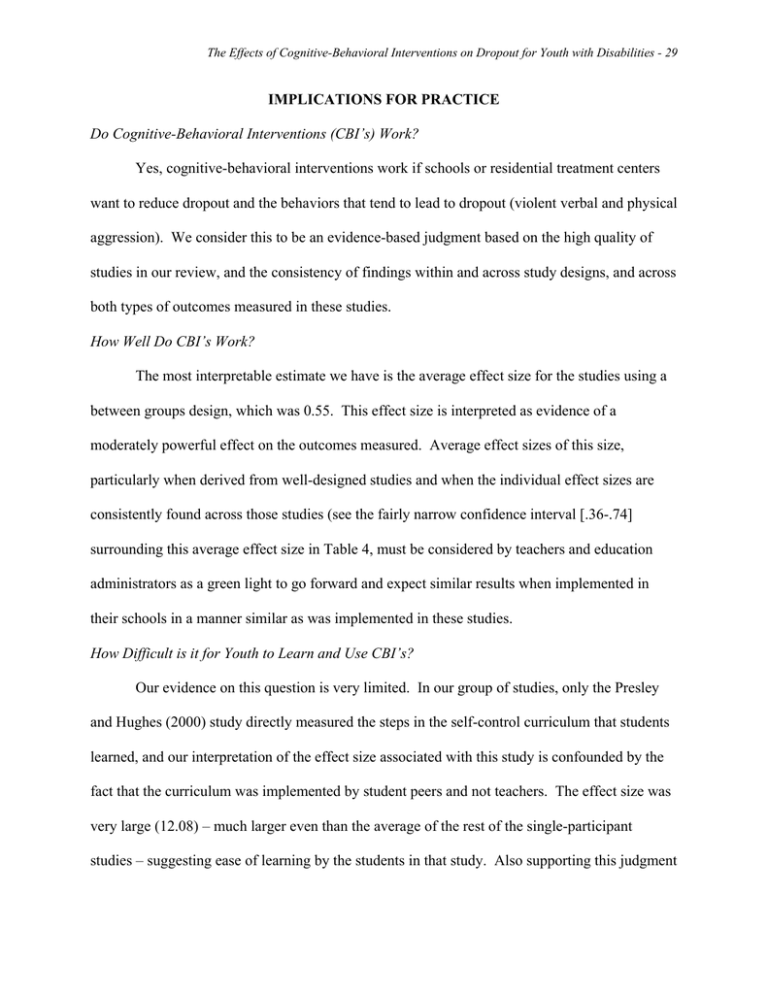Yes, cognitive-behavioral interventions work if
advertisement

The Effects of Cognitive-Behavioral Interventions on Dropout for Youth with Disabilities - 29 IMPLICATIONS FOR PRACTICE Do Cognitive-Behavioral Interventions (CBI’s) Work? Yes, cognitive-behavioral interventions work if schools or residential treatment centers want to reduce dropout and the behaviors that tend to lead to dropout (violent verbal and physical aggression). We consider this to be an evidence-based judgment based on the high quality of studies in our review, and the consistency of findings within and across study designs, and across both types of outcomes measured in these studies. How Well Do CBI’s Work? The most interpretable estimate we have is the average effect size for the studies using a between groups design, which was 0.55. This effect size is interpreted as evidence of a moderately powerful effect on the outcomes measured. Average effect sizes of this size, particularly when derived from well-designed studies and when the individual effect sizes are consistently found across those studies (see the fairly narrow confidence interval [.36-.74] surrounding this average effect size in Table 4, must be considered by teachers and education administrators as a green light to go forward and expect similar results when implemented in their schools in a manner similar as was implemented in these studies. How Difficult is it for Youth to Learn and Use CBI’s? Our evidence on this question is very limited. In our group of studies, only the Presley and Hughes (2000) study directly measured the steps in the self-control curriculum that students learned, and our interpretation of the effect size associated with this study is confounded by the fact that the curriculum was implemented by student peers and not teachers. The effect size was very large (12.08) – much larger even than the average of the rest of the single-participant studies – suggesting ease of learning by the students in that study. Also supporting this judgment The Effects of Cognitive-Behavioral Interventions on Dropout for Youth with Disabilities - 30 in an indirect manner is the fact that none of the study authors reported difficulties in implementing the curricula in their respective studies. Do CBI’s Work Equally Well for Different Kinds of Youth and Settings Our answer here is yes, they do, although the variability in types of youth with disabilities was limited largely to youth with moderate and severe behavior disorders, and who were largely male. Interestingly, one of the well-designed group studies (LeCroy, 1988) implemented a cognitive-behavioral intervention with just females and the results were among the most powerful from among our group of studies. CBI’s appear equally effective with younger and older adolescents as well, and in schools as well as in residential and day treatment centers or private specialized schools. What Happens if you Implement only the Cognitive Part of CBI’s and Leave out the Behavioral (Contingency Management) Part? We had two studies that addressed this question directly – the Barkley et al, (2001) study and the Etscheidt (1991) study. Barkley and his colleagues found a statistically significant difference in efficacy between their cognitive only intervention group and their cognitive plus behavioral group in favor of the cognitive plus behavioral group. Etscheidt (1991) found no significant differences between these two intervention groups, although she too noted that the cognitive plus behavioral treatment group evidenced greater effects (although not statistically significant) than the cognitive only group. It appears that eliminating the behavioral component reduces the efficacy of the CBI intervention. How Long Should You Implement CBI’s? Our evidence here is not direct. Nonetheless, many study authors recommended longer duration interventions rather than those of shorter duration. The Effects of Cognitive-Behavioral Interventions on Dropout for Youth with Disabilities - 31 What are the Most Common Elements of the Cognitive and Behavioral Components in These Studies? The most common curricular and instructional components of the CBI’s that were implemented in these studies were as follows (Table 3 describes the intervention components in more detail). Cognitive components. Training included curriculum in problem-solving, selfinstruction, communication skills, relaxation, and situational self-awareness. Instructional techniques included mentoring, teacher and peer modeling, role-playing and behavioral rehearsal (often with cartoon characters). Behavioral components. In addition to customary reinforcers of praise and recognition, the most common behavioral components of CBI’s were token economy point systems and behavioral contracting. Where can You Find Published Descriptions of These CBI Interventions? While all of the studies included in this review have, by our inclusionary criteria, reasonably complete descriptions of the interventions used, these descriptions are typically not as complete as they might be, most often due to space limitations in the journals in which the studies were published. However, several of the studies cited other work where interested individuals might find much more complete descriptions of precisely how to implement these CBI’s. We have not acquired all of these more detailed descriptions to affirm their comprehensiveness, but offer these additional citations for potential use by the reader, recognizing that many of these sources may be in fugitive literature as unpublished curricula and may be difficult to acquire. The Effects of Cognitive-Behavioral Interventions on Dropout for Youth with Disabilities - 32 In the Barkley et al, (2001) study, the authors cite: Barkley, Guevremont, Anastopoulos, & Fletcher (1992) and Robin and Foster (1989). In the Clarke et al, (1995) study, the authors cite: Clarke, Lewinsohn, and Hops, (1990). In the Etscheidt (1991) study, the author cited Lochman et al, ((1981). Where are the Best Descriptions of CBI’s as they were Implemented in These Studies? We recommend two studies – the Sinclair et al, (1998) study for a thorough description of a school-based dropout prevention CBI – and the Barkley et al, (2001) for a more counseling/therapy oriented CBI. Both studies were well-designed, had reasonably large sample sizes, and used high-quality randomization techniques. Both can be found in the companion piece to this review titled “Bottomlines”.


